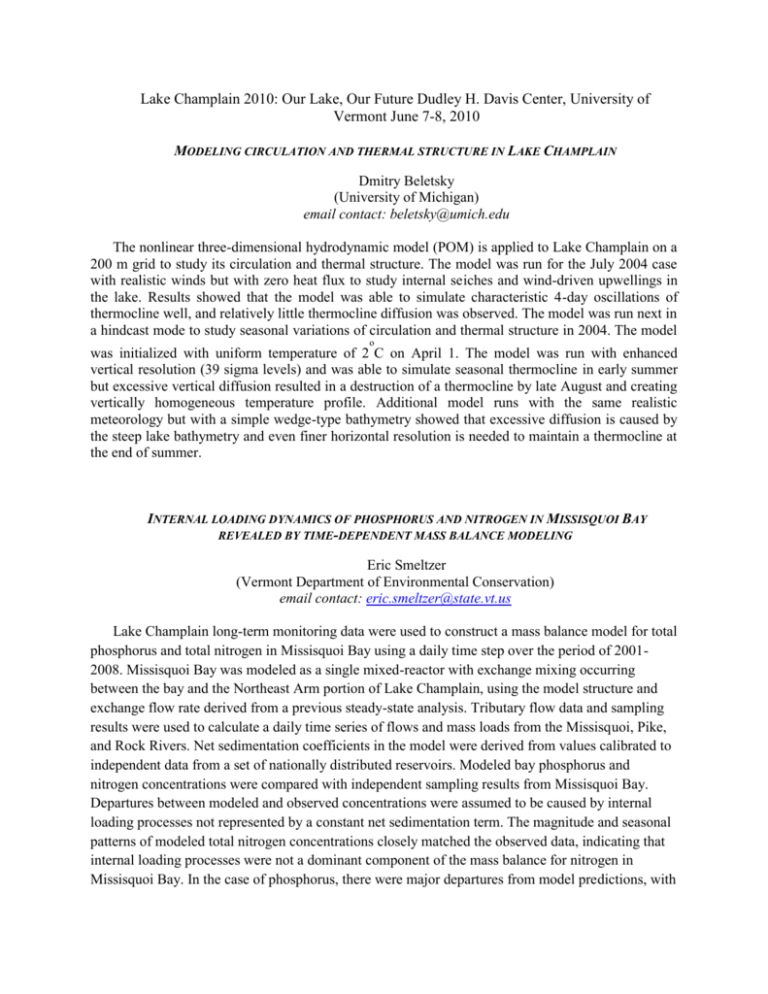Research Abstracts 2..
advertisement

Lake Champlain 2010: Our Lake, Our Future Dudley H. Davis Center, University of Vermont June 7-8, 2010 MODELING CIRCULATION AND THERMAL STRUCTURE IN LAKE CHAMPLAIN Dmitry Beletsky (University of Michigan) email contact: beletsky@umich.edu The nonlinear three-dimensional hydrodynamic model (POM) is applied to Lake Champlain on a 200 m grid to study its circulation and thermal structure. The model was run for the July 2004 case with realistic winds but with zero heat flux to study internal seiches and wind-driven upwellings in the lake. Results showed that the model was able to simulate characteristic 4-day oscillations of thermocline well, and relatively little thermocline diffusion was observed. The model was run next in a hindcast mode to study seasonal variations of circulation and thermal structure in 2004. The model o was initialized with uniform temperature of 2 C on April 1. The model was run with enhanced vertical resolution (39 sigma levels) and was able to simulate seasonal thermocline in early summer but excessive vertical diffusion resulted in a destruction of a thermocline by late August and creating vertically homogeneous temperature profile. Additional model runs with the same realistic meteorology but with a simple wedge-type bathymetry showed that excessive diffusion is caused by the steep lake bathymetry and even finer horizontal resolution is needed to maintain a thermocline at the end of summer. INTERNAL LOADING DYNAMICS OF PHOSPHORUS AND NITROGEN IN MISSISQUOI BAY REVEALED BY TIME-DEPENDENT MASS BALANCE MODELING Eric Smeltzer (Vermont Department of Environmental Conservation) email contact: eric.smeltzer@state.vt.us Lake Champlain long-term monitoring data were used to construct a mass balance model for total phosphorus and total nitrogen in Missisquoi Bay using a daily time step over the period of 20012008. Missisquoi Bay was modeled as a single mixed-reactor with exchange mixing occurring between the bay and the Northeast Arm portion of Lake Champlain, using the model structure and exchange flow rate derived from a previous steady-state analysis. Tributary flow data and sampling results were used to calculate a daily time series of flows and mass loads from the Missisquoi, Pike, and Rock Rivers. Net sedimentation coefficients in the model were derived from values calibrated to independent data from a set of nationally distributed reservoirs. Modeled bay phosphorus and nitrogen concentrations were compared with independent sampling results from Missisquoi Bay. Departures between modeled and observed concentrations were assumed to be caused by internal loading processes not represented by a constant net sedimentation term. The magnitude and seasonal patterns of modeled total nitrogen concentrations closely matched the observed data, indicating that internal loading processes were not a dominant component of the mass balance for nitrogen in Missisquoi Bay. In the case of phosphorus, there were major departures from model predictions, with increasing concentrations during the summer periods that were not accounted for by the external loads. The management implications of these findings are that internal loading processes could interfere with the bay’s response to phosphorus reductions from the watershed, but the bay should respond quickly to reductions in external nitrogen loads. SMALL-SCALE LACUSTRINE SEDIMENT DRIFTS IN LAKE CHAMPLAIN, VT 1 1 Patricia Manley , Thomas Manley , and Kathryn Hayo 1 2 2INSTAAR ( Middlebury College, , University of Colorado) email contact: manley@middlebury.edu A high-resolution seismic survey, using an EdgeTech Model 216 CHIRP system, revealed the presence of previously undocumented small-scaled lacustrine sediment drifts located within Juniper Deep basin in the Main Lake region of Lake Champlain, VT. These two north-south trending sediment deposits are positive features that differ from the normal drape sedimentation that characterizes deposition through out the Main Lake. The drifts are comprised of highly laminated sediments with reflectors that can be traced throughout both drifts. Two basic drift geometries have been identified. Drift A, the eastern deposit, is a confined elongate drift, while Drift B, the western deposit, is a detached elongate drift. The southern portion of Drift A overlies a series of acoustically transparent in-fill trough sediments. Northern portions of Drift A, as well as the sediments of Drift B, overlie acoustically transparent, drape sediments. Flanking the drifts are moats to the east and west and north-south oriented furrows are located north of Drift B. Acoustic Doppler Profilers were placed across the Drift A to determine flow dynamics. Drift A appears to be located at a shear zone between southward flowing and northward return flow conditions. Sediment cores taken across Drift A support these observations as the highest sedimentation rates occur within the shear boundary region. A basal reflector for both drifts has been correlated to an erosional feature believed to be the Champlain Sea- Lake Champlain sediment interface. This correlation suggest a starting time for drift formation beginning around 9,600 yrs. B.P.






